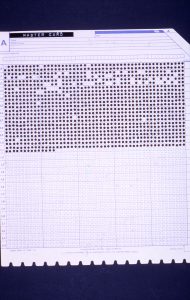Riding the crest of the wave of new technology is exciting. Perhaps it is like surfing — what I have seen of it. Slow to start, and when you are standing ups it’s perhaps too late to stop.
I can retrace my steps to my start in the quest for the holy grail of data storage. I did not mean to start out on this ride, but now I am up for the journey.
It’s not difficult for me to find my way back to the start; my journey is littered with the breadcrumbs of abandoned technology. It all started a long time ago
1. My first class project in medical school in 1969 involved collecting information and then recording it in longhand on paper. The annotated sheets were whisked away, transcribed onto punch cards and these were fed into the maw of the beast that was called a computer. It lived in its lair somewhere in the university, but we never got to see it. Eventually, we were presented with the answer and it was not 42. The data was stored perhaps forever on paper (more accurately as holes where the paper used to exist).
2. Ten years were to pass before I obeyed the instruction “publish or die” that was to haunt all aspiring surgeons, both then and now. Facts (gleaned at some cost) needed to be analysed.
I became the computer (my wife too). Information was put directly onto cards and we missed out the machine bit.
Was this a regressive step? We were in complete charge of data validity and calculations of sets and subsets and correlations were almost instant. Hunched over (Jolly Cards)[] and then holding sets of these cards up to the light was laborious but a fun thing to do together.

3. By 1981, I had moved on to (Cope Chatterton)[http://en.wikipedia.org/wiki/Edge-notched_card] cards. I could now study many data sets but for a limited number of patients. I could also write free text onto the card. The answers were only a knitting needle away.
4. By 1982, the age of the computer became personal (or at least accessible). The office (Cromemco Z2H)[http://infolab.stanford.edu/pub/voy/museum/pictures/display/3-5-CROMEMCO.html] allowed us to use (dBase)[http://t.eweek.com/eweek/#!/entry/30-years-ago-the-rise-fall-and-survival-of-ashtontates,523b72cd2ce9351e049e837c] to store and analyse our data.
There was however, one problem. The papers we wrote and databases we populated needed to be portable (I am referring to the actual physical storage here and not to the proprietary software format they were stored in).
4. The 8 inch floppy drive. Enormous in every sense except in the amount of data it could store. The drives were huge and slow, and most researchers (for I had moved on to study for my Master’s higher degree in Surgery) were limited to the one disc.
5. The 5 inch floppy was more affordable and most trainee surgeons could afford a box or two. The drives that read the discs were still out of most trainee’s pockets though.
Eventually, the price fell and soon, a dual floppy drive setup enabled easy disc copying and a form of backups
6. The holy grail was soon to come. My first hard drive was a massive 20MB in capacity. Sadly, all disc drives fail; the heads floating just above the spinning platters touch the delicate surface and leave their mark. Bits are lost, never to return.
The quest continues for the holy grail. All my data available for a reasonable cost, anywhere, anytime and no lag.
Next time:
Portable storage
The Cloud
Backup
Gigabytes and Terabytes
RAID
SSD
